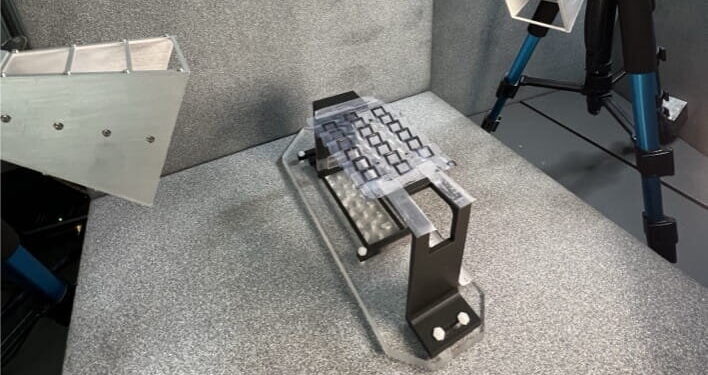Credit: Drexel University
The future of wireless technology – from charging devices to amplifying communications signals – relies on antennas that transmit electromagnetic waves becoming increasingly versatile, durable and easy to manufacture. Researchers at Drexel University and the University of British Columbia believe that kirigami, the ancient Japanese art of cutting and folding paper to create complex three-dimensional patterns, could provide a model for making paper. next generation of antennas.
Recently published in the journal Natural communicationsResearch by the Drexel-UBC team showed how kirigami, a variation of origami, can transform a single sheet of acetate coated with conductive MXene ink into a flexible 3D microwave antenna whose transmission frequency can be adjusted simply by pulling or pressing to slightly shift its frequency. shape.
The proof of concept is important, the researchers say, because it represents a new way to make an antenna quickly and cost-effectively by simply applying aqueous MXene ink to a transparent elastic polymer substrate.
“For wireless technology to support advancements in areas such as soft robotics and aerospace, antennas must be designed to provide tunable performance and easy manufacturing,” said Yury Gogotsi, Ph.D., Distinguished University and Bach Professor at Drexel College of Engineering. and co-author of the research. “Kirigami is a natural template for a manufacturing process, because of the simplicity with which complex 3D shapes can be created from a single piece of 2D material.”
Standard microwave antennas can be reconfigured electronically or by changing their physical shape. However, adding the circuitry needed to electronically control an antenna can increase its complexity, making the antenna bulkier, more vulnerable to malfunction, and more expensive to manufacture.
In contrast, the process demonstrated in this joint work exploits physical shape shifting and can create antennas of various complex shapes and forms. These antennas are flexible, lightweight and durable, factors crucial to their survivability on mobile robotics and aerospace components.
To create the test antennas, the researchers first coated a sheet of acetate with a special conductive ink, made from MXene titanium carbide, to create frequency-selective patterns. MXene ink is particularly useful in this application because its chemical composition allows it to adhere strongly to the substrate for a durable antenna and can be adjusted to reconfigure the antenna’s transmission specifications.
MXenes are a family of two-dimensional nanomaterials discovered by Drexel researchers in 2011 whose physical and electrochemical properties can be tuned by slightly modifying their chemical composition. MXenes have been widely used over the past decade for applications requiring materials with precise physicochemical behavior, such as electromagnetic shielding, biofiltration, and energy storage.
They have also been explored for telecommunications applications for many years due to their efficiency in transmitting radio waves and their ability to be adjusted to selectively block and allow the transmission of electromagnetic waves.
Using kirigami techniques, originally developed in Japan in the 4th and 5th centuries AD, the researchers made a series of parallel cuts in the MXene-covered surface. Pulling the edges of the sheet, a square-shaped resonator antenna array sprouted from its two-dimensional surface. Varying the voltage caused the array angle to shift, a capability that could be deployed to quickly adjust the antennas’ communications configuration.
The researchers assembled two kirigami antenna arrays for testing purposes. They also created a prototype coplanar resonator – a component used in sensors that naturally produces waves of a certain frequency – to demonstrate the versatility of the approach. In addition to communications applications, reconfigurable resonators and antennas could also be used for strain sensing, according to the team.
“Frequency-selective surfaces, like these antennas, are periodic structures that selectively transmit, reflect or absorb electromagnetic waves at specific frequencies,” said Mohammad Zarifi, principal research chair and associate professor at UBC , who helped lead the research.
“They have active and/or passive structures and are commonly used in applications such as antennas, radomes and reflectors to control the direction of wave propagation in wireless communications on 5G platforms and beyond.”
Kirigami antennas have been shown to be effective in transmitting signals in three commonly used microwave frequency bands: 2-4 GHz, 4-8 GHz, and 8-12 GHz. Additionally, the team discovered that changing the geometry and direction of the substrate could redirect the waves from each resonator.
The frequency produced by the resonator shifted by 400 MHz as its shape deformed under stress conditions, demonstrating that it could function effectively as a stress sensor to monitor the condition of infrastructure and buildings.
According to the team, these results are the first step toward integrating the components onto relevant wireless structures and devices. Inspired by the countless forms of kirigami, the team will now seek to optimize the performance of the antennas by exploring new shapes, substrates and movements.
“Our goal here was to simultaneously improve the tunability of antenna performance and create a simple manufacturing process for new microwave components by incorporating a versatile nanomaterial MXene with kirigami-inspired designs,” said Omid Niksan, Ph.D., of the University of British Columbia, who authored the paper. “The next phase of this research will explore new materials and geometries for antennas.”
More information:
Omid Niksan et al, MXene-based kirigami designs: presentation of reconfigurable frequency selectivity in microwave regime, Natural communications (2024). DOI: 10.1038/s41467-024-51853-1
Provided by Drexel University
Quote: Ancient 3D paper art, kirigami, could reshape modern wireless technology (October 14, 2024) retrieved October 14, 2024 from
This document is subject to copyright. Except for fair use for private study or research purposes, no part may be reproduced without written permission. The content is provided for informational purposes only.



